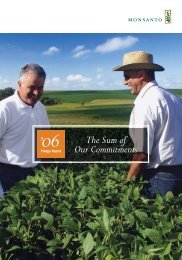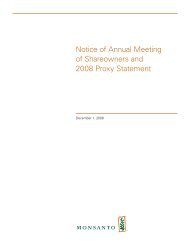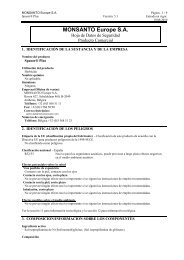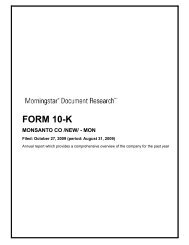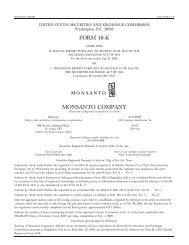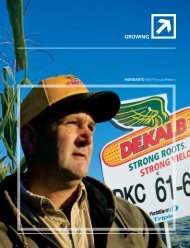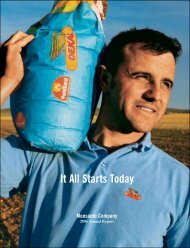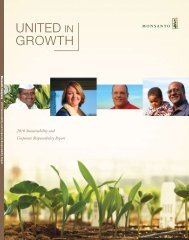You also want an ePaper? Increase the reach of your titles
YUMPU automatically turns print PDFs into web optimized ePapers that Google loves.
13 Sachs, J. (2003, October). The millennium compact and the<br />
end of hunger. In M. S. Swaminathan (Chair), World Food Prize<br />
Symposium. Des Moines, IA.<br />
14 Strength of partnerships contributes to lasting success<br />
in Africa. (2004, April). Winrock International Innovations:<br />
Putting ideas to work. Retrieved August 2, 2004, from<br />
http://newsletter.winrock.org/April04/<br />
15 Center for Science in the Public Interest. (2004, May 18).<br />
TransFreeAmerica campaign launched. Retrieved August 2,<br />
2004, from http://www.cspinet.org/new/200405181.html<br />
16 De Roos, N. M., Bots, M. L., & Katan, M. B. (2001).<br />
Replacement of dietary saturated fatty acids by trans fatty<br />
acids lowers serum HDL cholesterol and impairs endothelial<br />
function in healthy men and women. Arteriosclerosis,<br />
Thrombosis, and Vascular Biology, 21, 1233-1237.<br />
17 United Soybean Board. (2001, December 6). Unique fall<br />
harvest may yield healthier soybean oil. Retrieved August 2,<br />
2004, from http://www.talksoy.com/pdfs/Harvestrelease/pdf<br />
18 Intergovernmental Panel on Climate Change. (2001). Climate<br />
change 2001: Third assessment report (R. T. Watson, Ed.).<br />
Cambridge, UK: Cambridge University Press.<br />
19 Rosenberg, N. J., Izaurralde, R. C., & Malone, E. L. (1998).<br />
Proceedings of the St. Michael’s workshop on Soil<br />
Sequestration. In Soil: Science, Monitoring and Beyond.<br />
Battelle Press.<br />
20 Robertson, G. P. (2001, June 18). Better farming can aid<br />
global warming battle: No-till methods produce fewer<br />
greenhouse gases [Electronic version]. Detroit Free Press.<br />
21 Intergovernmental Panel on Climate Change. (2000).<br />
Land: Use, change, and forestry. Cambridge, UK: Cambridge<br />
University Press.<br />
Note: No-till CO2 sequestration calculation based on the fact<br />
that a gallon of gasoline weighs 6.2 lbs., contains 5.39 lbs.<br />
of carbon and emits 19.8 lbs. of CO2 when burned. Example<br />
0.75 tons of C sequestered with conservation tillage multiplied<br />
by 2000 lbs. in a ton divided by 19.8 lbs. of CO2 in a<br />
gallon of gasoline is equivalent to not burning 75 gallons<br />
of gasoline. Fuel reduction source: Conservation Technology<br />
Information Center.<br />
22 Wang, M., Saricks, C., & Santini, D. (1999). Effects of<br />
fuel ethanol use on fuel-cycle energy and greenhouse<br />
gas emissions (ANL/ESD-38). Argonne, IL: Center for<br />
Transportation Research, Energy Systems Division.<br />
23 James, C. (2002). Global review of commercialized<br />
transgenic crops: 2001 Feature: Bt cotton. (ISAAA-26).<br />
Ithaca, NY: International Service for the Acquisition of<br />
Agri-Biotech Applications.<br />
24 Huang, J., Hu, R., Fan, C., Pray C. E., & Rozelle, S. (2003,<br />
September). Bt cotton benefits, costs, and impacts in China<br />
(IDS working paper 202). Brighton, UK: Institute of<br />
Development Studies.<br />
25 Pray, C. E., Huang, J., Hu, R., & Rozelle, S. (2002). Five years<br />
of Bt cotton in China — the benefits continue. The Plant<br />
Journal, 31, 423-430.<br />
26 Morse, S., Bennett, R., & Ismael, Y. (2004). Why Bt cotton<br />
pays for small-scale producers in South Africa. Nature<br />
Biotechnology, 22, 379-380.<br />
27 Traxler, G., Godoy-Avila, S., Falck-Zepeda, Espinoza-Arellano,<br />
& J. De Jesús. (2003). Transgenic cotton in Mexico: A case<br />
study of the Comarca Lagunera. In: N. G. Kalaitzandonakes<br />
(Ed.), The economic and environmental impacts of agbiotech<br />
— a global perspective. New York: Kluwer.<br />
28 Qaim, M., Cap, E. J., & De Janvry, A. (2003). Agronomics and<br />
sustainability of transgenic cotton in Argentina. AgBioForum,<br />
6, 41-47.<br />
29 James, C. (2003). Global review of commercialized transgenic<br />
crops: 2002. Feature: Bt Maize (ISAAA-29). Ithaca, NY:<br />
International Service for the Acquisition of Agri-Biotech<br />
Applications.<br />
30 James, C. (2003). Preview: Global status of commercialized<br />
transgenic crops: 2003 (ISAAA-30). Ithaca, NY: International<br />
Service for the Acquisition of Agri-Biotech Applications.<br />
31 Pietri, A., & Piva, G. (2000). Occurrence and control of<br />
mycotoxins in maize grown in Italy. In: G. Piva & F. Mascero<br />
(Eds.), International Feed Conference: Vol. 6. Feed safety:<br />
Current situation and perspectives in the European<br />
community (pp. 226-236). Piancenza, Italy.<br />
32 Bakan, B., Melcion, D., Richard-Molard, D., & Cahagnier, B.<br />
(2002). Fungal growth and fusarium mycotoxin content in<br />
isogenic traditional maize and genetically modified maize<br />
grown in France and Spain. Journal of Agricultural and<br />
Food Chemistry, 50, 728-731.<br />
33 Hammond, B., Campbell, K., Pilcher, C., Degooyer, T.,<br />
Robinson, A., Rice, L., et al. (2002). Reduction of fungal and<br />
fumonisin levels in Bt corn. Mycopathologia, 155, 20.<br />
34 Hammond, B. G., Campbell, K. W., Pilcher, C. D., Degooyer,<br />
T. A., Robinson, A. E., McMillen, B. L. et al. (2004). Lower<br />
fumonisin mycotoxin levels in the grain of Bt corn grown in<br />
the United States in 2000-2002. Journal of Agricultural and<br />
Food Chemistry, 52, 1390-1397.<br />
35 Food and Agriculture Organization of the United Nations.<br />
(n.d.). Gender and food security: Agriculture. Retrieved August<br />
2, 2004, from http://www.fao.org/Gender/en/agri-e.htm<br />
{ MONSANTO COMPANY 2004 PLEDGE REPORT: PAGES 48-49 }



